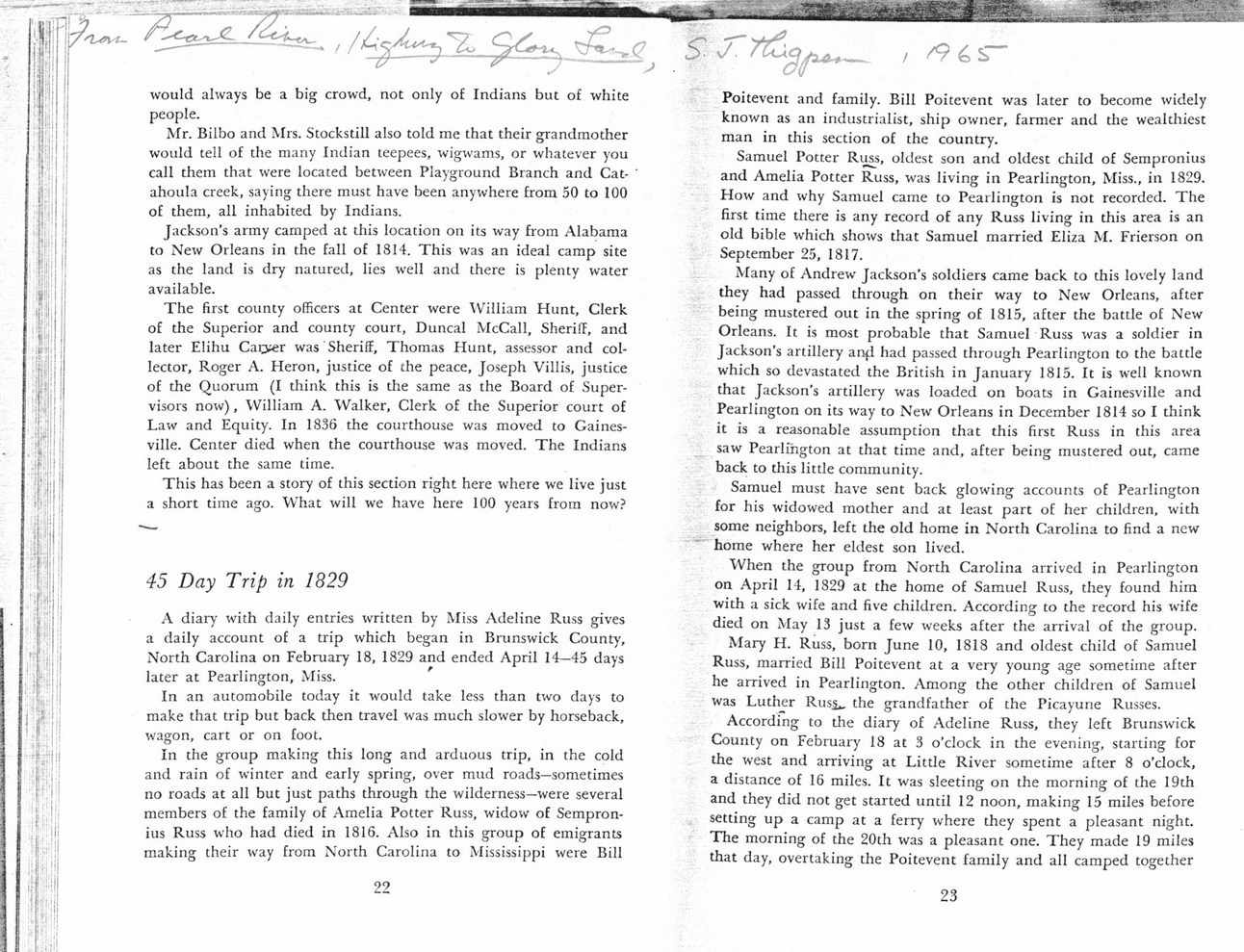This text was obtained via automated optical character recognition.
It has not been edited and may therefore contain several errors.
IP sVvvi- would always be a big crowd, not only of Indians but of white people. Mr. Bilbo and Mrs. Stockstill also told me that their grandmother would tell of the many Indian teepees, wigwams, or whatever you call them that were located between Playground Branch and Catahoula creek, saying there must have been anywhere from 50 to 100 of them, all inhabited by Indians. Jackson?s army camped at this location on its way from Alabama to New Orleans in the fall of 1814. This was an ideal camp site as the land is dry natured, lies well and there is plenty water available. The first county officers at Center were William Hunt, Clerk of the Superior and county court, Duncal McCall, Sheriff, and later Elihu Caiyer was Sheriff, Thomas Hunt, assessor and collector, Roger A. Heron, justice of the peace, Joseph Villis, justice of the Quorum (I think this is the same as the Board of Supervisors now), William A. Walker, Clerk of the Superior court of Law and Equity. In 1836 the courthouse was moved to Gainesville. Center died when the courthouse was moved. The Indians left about the same time. This has been a story of this section right here where we live just a short time ago. What will we have here 100 years from now? 45 Day Trip in 1829 A diary with daily entries written by Miss Adeline Russ gives a daily account of a trip which began in Brunswick County, North Carolina on February 18, 1829 and ended April 14?45 days later at Pearlington, Miss. In an automobile today it would take less than two days to make that trip but back then travel was much slower by horseback, wagon, cart or on foot. In the group making this long and arduous trip, in the cold and rain of winter and early spring, over mud roads?sometimes no roads at all but just paths through the wilderness?were several members of the family of Amelia Potter Russ, widow of Sempron-jl ius Russ who had died in 1816. Also in this group of emigrants i| making their way from North Carolina to Mississippi were Bill '""I! 22 ifl:1! ?tMi; S'- 'J ? ^ ^ ^ Poitevent and family. Bill Poitevent was later to become widely known as an industrialist, ship owner, farmer and the wealthiest man in this section of the country. Samuel Potter Russ, oldest son and oldest child of Sempronius and Amelia Potter Russ, was living in Pearlington, Miss., in 1829. How and why Samuel came to Pearlington is not recorded. The first time there is any record of any Russ living in this area is an old bible which shows that Samuel married Eliza M. Frierson on September 25, 1817. Many of Andrew Jackson's soldiers came back to this lovely land they had passed through on their way to New Orleans, after being mustered out in the spring of 1815, after the battle of New Orleans. It is most probable that Samuel Russ was a soldier in Jackson?s artillery anfl had passed through Pearlington to the battle which so devastated the British in January 1815. It is well known that Jackson's artillery was loaded on boats in Gainesville and Pearlington on its way to New Orleans in December 1814 so I think it is a reasonable assumption that this first Russ in this area saw Pearlington at that time and, after being mustered out, came back to this little community. Samuel must have sent back glowing accounts of Pearlington for his widowed mother and at least part of her children, with some neighbors, left the old home in North Carolina to find a new home where her eldest son lived. When the group from North Carolina arrived in Pearlington on April 14, 1829 at the home of Samuel Russ, they found him with a sick wife and five children. According to the record his wife died on May 13 just a few weeks after the arrival of the group. Mary H. Russ, born June 10, 1818 and oldest child of Samuel Russ, married Bill Poitevent at a very young age sometime after he arrived in Pearlington. Among the other children of Samuel was Luther Rus&, the grandfather of the Picayune Russes. According to the diary of Adeline Russ, they left Brunswick County on February 18 at 3 o?clock in the evening, starting for the west and arriving at Little River sometime after 8 o?clock, a distance of 16 miles. It was sleeting on the morning of the 19th and they did not get started until 12 noon, making 15 miles before setting up a camp at a ferry where they spent a pleasant night. The morning of the 20th was a pleasant one. They made 19 miles that day, overtaking the Poitevent family and all camped together 23

Pearl Rivers Thigpen Daytrip in 1829-1